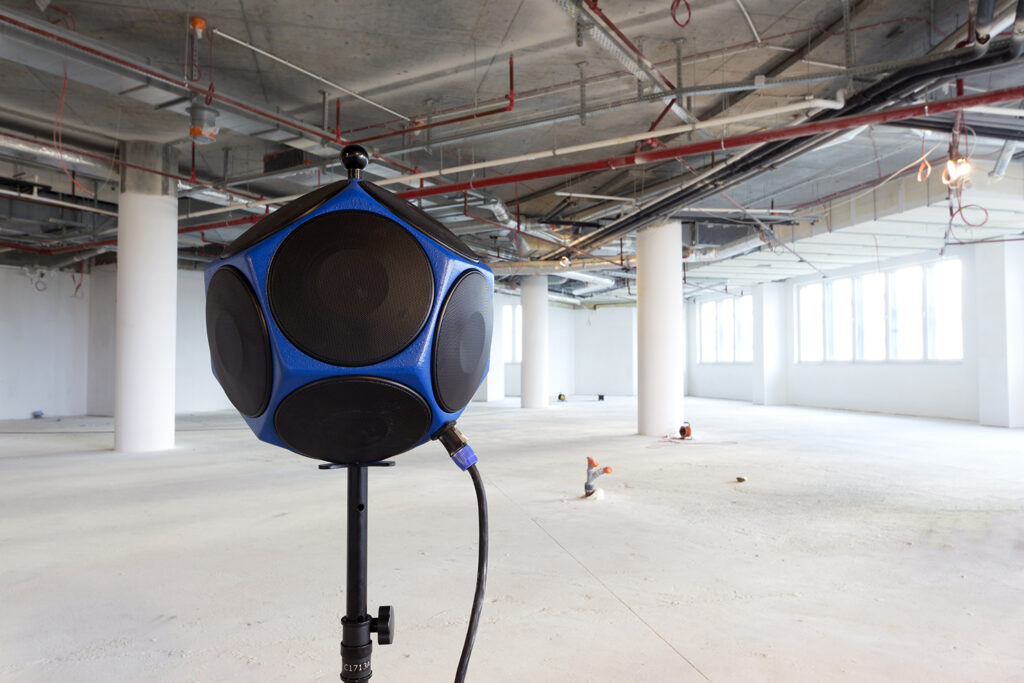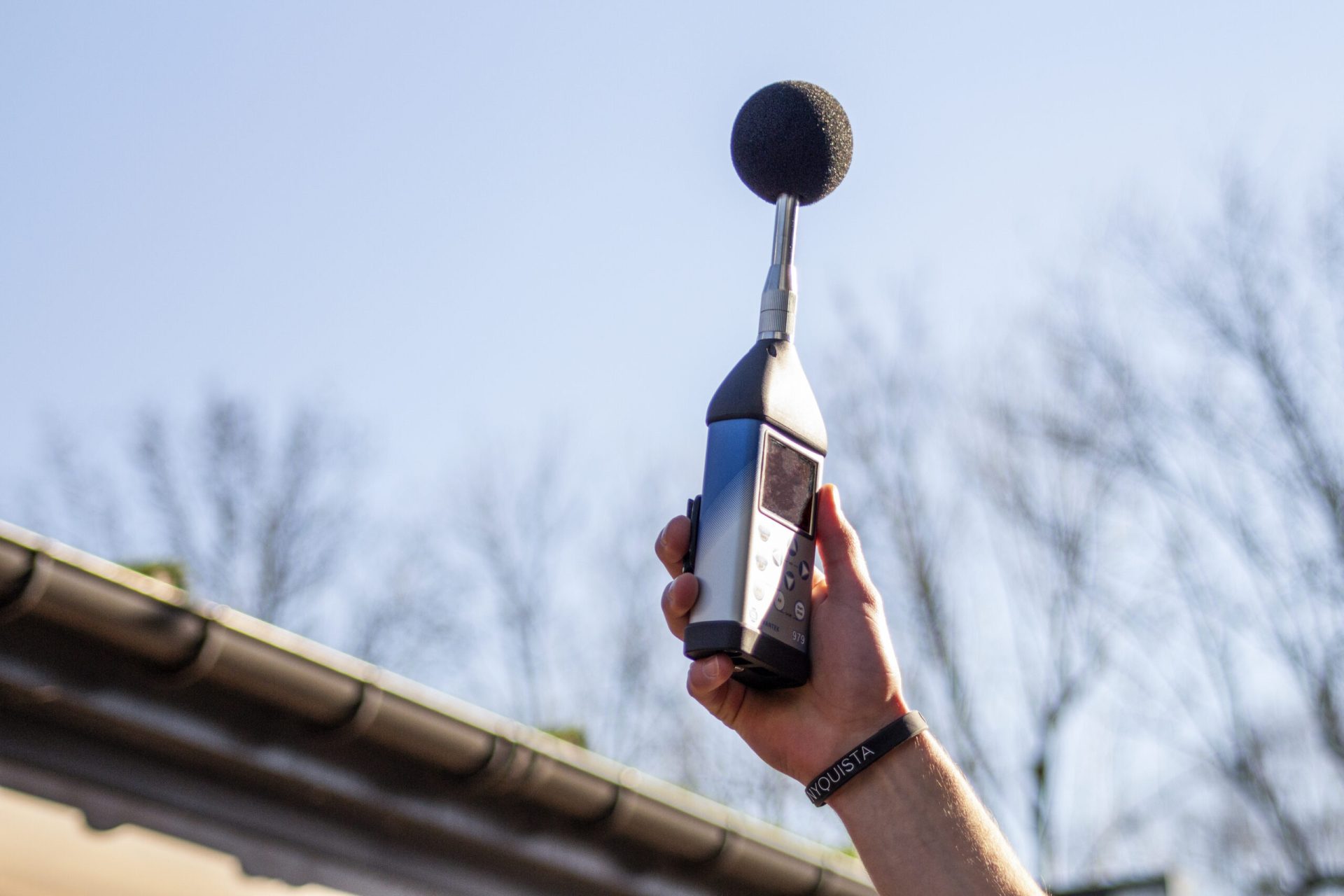Acoustic measurements
Taking acoustic measurements will allow you to learn about the sound parameters of your space and locate and correct related problems. The results of the measurements can be used as input information for designers, who can use them as a basis for finding the optimal solutions to improve the acoustics in your room.
Common questions:
Acoustic measurements are engineering tests aimed at investigating the acoustic conditions of rooms, determining the level of environmental noise caused by, for example, the close proximity of a railway crossing, an air corridor or simply increased traffic in a city center, and testing noise in the working environment to ensure the safety of employees.
Thanks to the measurements, we can examine acoustic parameters such as:
- Reverberation time in RT30 / RT60 room
- Acoustic insulation of building partitions
- Acoustic insulation against impact sounds
- STI speech transmission (intelligibility) index
- Environmental noise level
- Noise level from machines and devices in the working environment
- Vibration levels in construction
- Industrial vibration levels
Inadequate acoustic conditions in the spaces we live in have a negative impact on many aspects of our lives. Fatigue, discomfort or concentration problems at work are just a few of them. Acoustic measurements make it possible to precisely determine the parameters and their effects on the comfort of living in the rooms under investigation. Thanks to these measurements, we can easily adjust the type and degree of adaptation to improve the acoustic properties of the spaces and the comfort of staying in them.


Thanks to the acoustic measurements, you will get to know the acoustics of your room in detail! They will allow you to define the parameters to which we will propose a solution.

Rodzaje pomiarów akustycznych
We carry out acoustic measurements in accordance with the accredited methodology, applicable PN and ISO standards and legal regulations. For this purpose, we use certified measuring equipment of the highest class 1. With us, you get a guarantee that the acoustic measurements were made by an authorized entity and in accordance with all requirements. Each study ends with an acoustic analysis containing guidelines and design recommendations.
Below you will find the most common acoustic measurements:
Measurement of acoustic insulation allows to assess to what extent the wall or ceiling effectively insulates the noise coming from another room or from the outside. We measure the insulation of internal and external building partitions against airborne and impact sounds. We test the insulation of individual elements such as: windows, doors, sliding walls or soundproof casings.
We carry out noise and reverberation measurements in all types of rooms. These are, for example: offices, conference rooms, concert halls, auditoriums, recording studios, sports halls, schools, museums, hotels, offices, etc. The parameters to be tested include: reverberation time, speech intelligibility, sound clarity and clarity, curve measurement noise, room impulse response and much more.
We perform noise measurements at the workplace in any environment. They are carried out using the following methods: with a division into activities, bench measurements and all-day measurements. We analyze working conditions in order to select the appropriate measurement methodology, including identifying the type of noise for individual workstations, identifying groups with the same noise exposure, identifying typical activities during the working day or week.
We measure the noise produced by building devices and technical equipment. We perform acoustic power measurement, noise measurement from HVAC, sanitary, water and sewage installations, voice alarm systems, aggregates, pumps, generators, elevators, etc. We prepare a report containing an analysis, assessment of compliance with regulations and design guidelines.
Thanks to vibration measurements, we locate the source of the sound and the path of its transmission. To select the appropriate vibration isolation solutions, we also check the frequency range of the noise source. We measure the vibration transmission coefficient through technical installations, machines, walls, ceilings and structural elements of the building. We also verify the effectiveness of the existing vibration isolation protections.
Thanks to vibration measurements, we locate the source of the sound and the path of its transmission. To select the appropriate vibration isolation solutions, we also check the frequency range of the noise source. We measure the vibration transmission coefficient through technical installations, machines, walls, ceilings and structural elements of the building. We also verify the effectiveness of the existing vibration isolation protections.
Contact form
FAQ
Frequently Asked Questions.
Acoustic measurements are not always needed to properly plan the conditions. Sometimes calculations or computer simulations are enough. There are many types of acoustic measurements. In most cases, their type, method of execution and application are described in Polish and EU PN and ISO standards. Our acousticians will select the appropriate measurement method for the prevailing conditions.
First of all, measurements must be made in accordance with procedures and with the use of appropriate equipment, the specificity of which is specified by acoustic standards. When testing insulation, noise and reverberation, it is advisable to ensure the lowest possible noise level - the so-called acoustic background. Measurements are best done in the evening or at night.
In the case of measurements at workplaces, the appropriate measurement methodology must first be determined, depending on the nature of the work performed.
The minimum requirements for what should be included in the "measurement analysis" are defined by standards and legal regulations. Our analysis of measurements, in addition to the necessary minimum in the form of calculations, data analysis and compliance with regulations, also includes guidelines for the acoustic design. The price of measurements also includes consultations and assistance in solving specific problems.
Yes, provided that the acoustic measurements are made in accordance with applicable standards and legal regulations and by an authorized entity. Some types of measurements can only be performed by entities with appropriate accreditation. Nyquista performs all kinds of acoustic measurements in accordance with accredited methods. We also provide legal and substantive assistance. We support talks / negotiations with other entities.
Measurements and acoustic simulations are priced individually. The price depends on the size of the investment, the number of rooms, the type and complexity of the project. In order to obtain an accurate quote, it is best to consult our acoustician or send us the current investment plans with a description of the problem.
According to the Polish standard PN-B-02151, each new building must meet certain acoustic requirements. In the case of basic standard buildings, the minimum requirements are specified in parts 2-4 of the above-mentioned. standards. In the case of higher-standard residential buildings, the requirements are set out in part 5 of this standard. In order to verify whether a given premises / building meets the current legal requirements, acoustic measurements should be carried out with the use of appropriate equipment and with the methods specified in the standards.
There are many sound insulation systems. Unfortunately, there is no one-size-fits-all solution. First of all, it is necessary to determine the source, type and precisely indicate the routes of noise transmission. For this purpose, acoustic measurements are most often required. Sometimes it seems to us that noise penetrates, for example, through the ceiling, while the problem is the facade wall, construction columns or the ventilation system.
Yes, current computer programs allow you to simulate almost all acoustic parameters, e.g. wall insulation, noise from technical installations, speech intelligibility or sound dispersion. The earlier we start planning the appropriate acoustic conditions, the lower the risk of faults and problems at a later stage. Acoustic simulation is often the only chance to avoid architectural mistakes, the improvement of which at a later stage is sometimes costly or even impossible.
As a rule, the earlier we take into account the acoustic conditions of a given building, the better. Starting with the location of the building, the construction materials used, and ending with the design of technical installations and interior design, each stage is important. However, no matter which of these stages you are at, we will advise you on the most effective solutions.
First of all, we verify the compliance of the planned investment with the applicable regulations and acoustic standards. We are looking for potential threats and acoustic faults that may occur during the implementation. We advise effective materials and acoustic panels and prepare a preliminary cost estimate. We conduct acoustic simulations for selected rooms or the entire building. If necessary, we supervise the correct implementation of the project.
If you have any questions or concerns regarding acoustic issues, you can call us, write to us or make an appointment. We will be happy to answer you as much as possible. In the case of more complex projects, we offer paid consultations, implementation of an acoustic project or supervision over the implementation of a given investment.



